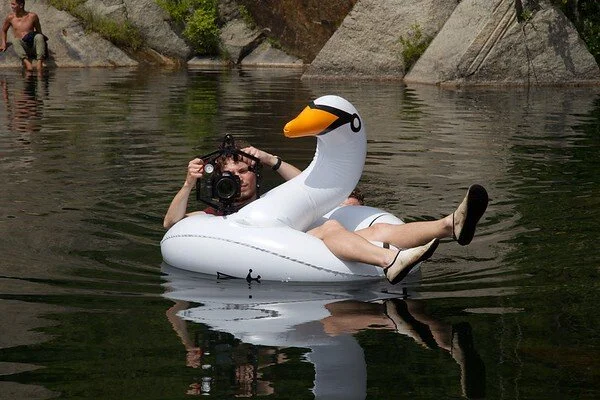Videographer Anders Johnson, at a secret location for this year’s film version of Quarry Dance. Peter Van H. Demark photograph
Cancelling the annual Quarry Dance this summer was one of the cruelest blows of the pandemic.
For eight years the Dušan Týnek Dance Theatre has realized Ina Hahn’s dream. Hahn, choreographer and creator of Windhover Center for the Performing Arts in Rockport, passed away in 2016. Before she died, she had brought Tynek’s Brooklyn-based troupe to Windhover each year for workshops and performances—including the site-specific Quarry Dance, which moved each summer from one magnificently remote quarry location to another.
Hundreds of dance lovers would trek into the woods—visiting Little Parker’s Pit or Valley Pit or Deep Pit—to see the imaginative, fanciful work that Tynek would create at the site.
But this year, not even a gathering in the woods was possible. So a Quarry Dance film was created instead.
Týnek, along with videographer Anders Johnson and producer Lisa Hahn—Ina’s daughter, current executive director at Windhover—filmed his dancers in small groups in July, at three remote quarry locations. The resulting film—in the final stages of production—will be released, free to the public, at the end of the month.
It not only continues the Quarry Dance tradition, but provides a glimpse of locations that would never be possible for the large audience that the dances attract.
Alexandra Berger performs in Quarry Dance 9. Peter H. Van Demark photograph
“This film is about making the Quarry Dances accessible,” Týnek says. “It’s not always available to all. Not everyone can walk out to the site. But this year, we were able to go to places that could not have an audience. That expanded the idea for us—it didn’t feel like a substitution.”
The location of the three quarries remains anonymous for privacy. Týnek used a smaller version of his troupe, and worked in discrete stages, to put the film together. Dancers Alexandra Berger, Elizabeth Hepp, Jessica Cipriano and Gary Champi are featured. Composer/instrumentalist Russ Gershon is adding an improvised score as the final part of the process.
“We were mitigated by Covid,” Týnek says. “We spaced it out in pairs, whoever was comfortable. They came for two days—one day was choreography, the second day Anders would film. It was complete mayhem—we had such a short time for creation.
“It was done piecemeal, in vignettes,” he says. “We were able to access quarries that are not usually available, and that made it special to work there.”
Choreographing a dance, and choreographing a film of a dance, aren’t precisely the same thing. Viewers will see a faster-cut, more episodic version of Quarry Dance—much different than the leisurely, meditative expression they’ve previously experienced.
“Anders and I didn’t know each other, so there were no expectations,” Týnek says. “He was very open. At the first shoot I immediately made him grab his camera and go into the water in this inflatable swan.
“He shot thirteen hours,” Týnek says. “Each day was a different quality. The dancers were still learning the choreography, and everyone was still learning the layout. It was fun, but it was a challenge.
“You had to go with the first idea—you go with instincts. It’s all about the topography, how the body can play on the topography. You let go of the editing mind.”
Týnek avoided choreographing with direct references to the pandemic, although it’s hard to miss its impact. “It’s kind of clear,” he says, “you only see two dancers at a time. I’m usually heavy, with lots of partnering. This year, there’s none. Dancers can’t touch. There’s just one moment when someone gets close, one duet that’s a play on social distancing—mirroring, almost a ballroom dance without physical contact.
“For the dancers, it’s a marathon,” he says, “moving from one rock to another. In the end, it’s like a meditation on the landscape, condensed from three different locations.
“You view dance differently through the lens. The camera chooses what you see. It was very enriching experience to see movement that way.”
Quarry Dance IX will be available in late September. At the film’s release, there will be several livestream events, Q&A sessions with Týnek and the artists. All will be free to the public. Visit windhover.org or call 978-546-3611.
Keith Powers covers music and the arts for Gannett New England, Opera News and Leonore Overture. Follow @PowersKeith; email to keithmichaelpowers@gmail.com



